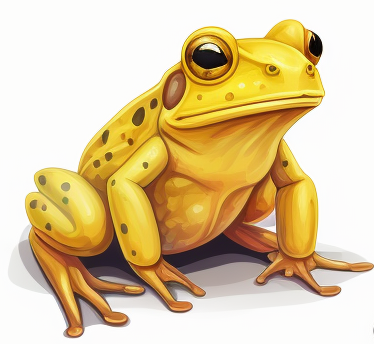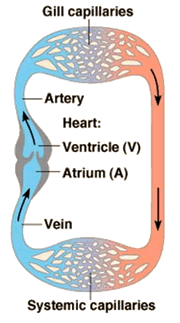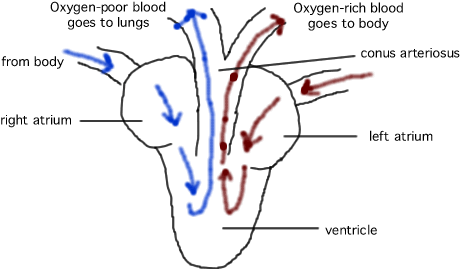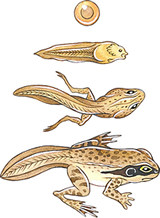Amphibians - Form, Function, and Classification

Amphibians are a class of vertebrates that typically live part of their lives in water and part on land. They undergo a remarkable metamorphosis from an aquatic larval stage (like tadpoles in frogs) to an adult stage that can breathe both through lungs and, often, their skin. Examples include frogs, toads, salamanders, and newts. Their dual life strategy allows them to inhabit diverse environments.
*Herpetology is the study of reptiles and amphibians

What is an amphibian?
1. Moist, Permeable Skin: Amphibians have thin, moist, and permeable skin that allows them to breathe through their skin, in addition to their lungs, enabling gas exchange. This skin is sensitive to environmental changes and is susceptible to dehydration.
2. Limbs: Most amphibians have four limbs, although some, like caecilians, may have reduced or no limbs at all. Their limbs are adapted for movement on land and in water. The skeletal structure and musculature support both swimming and walking.
3. Metamorphosis: Many amphibians undergo metamorphosis, starting their lives as aquatic larvae (like tadpoles) and eventually transforming into adults adapted for a terrestrial lifestyle. During this process, they often undergo significant changes in their body structure, including the development of lungs (from gills) for breathing air and changes in their digestive and sensory systems.
4. Dual Respiratory System: As mentioned earlier, amphibians typically have a dual respiratory system, utilizing both lungs and their skin for respiration. This allows them to breathe in oxygen from the air and water.
5. Moisture-Regulating Glands: Amphibians have specialized glands on their skin that secrete mucus to keep their skin moist, aiding in respiration and protecting against infections.
6. Eyes and Sensory Organs: They usually have well-developed eyes and sensory organs suited for their habitat. Some species have special adaptations, like the lateral line system in aquatic species that helps detect movements and vibrations in water.
Evolutionary adaptations for life on land:
1. stronger bones
2. lungs and breathing tubes
3. sternum (breastbone) and ribs to protect internal organs
History:
Carboniferous Period = Age of Amphibians, 360-290 million years ago
Climate changes caused habitats to disappear
3 orders of amphibians survive today;
1. Frogs and Toads
2. Salamanders
3. Caecilians
Form and Function in Amphibians
1. Feeding: larvae = herbivore, adults = mostly carnivore
Digestive tract; mouth > esophagus > stomach > small intestines > large intestine (colon) > cloaca
2. Respiration: larva = skin and gills, adult = lungs and some through skin
Many terrestrial salamanders = no lungs at all, through skin and mouth cavity
3. Circulation: double loop system
3 chamber heart right atrium, left atrium, and ventricle
Compare Single to Double Loop Circulation
Single: Heart --> Gills --> Body
Double: Heart --> Lungs --> Heart --> Body


4. Excretion: kidneys filter liquid waste = urine
Kidneys > ureters > small urinary bladder > cloaca
5. Reproduction: females lay eggs in water, male deposits sperm over eggs
Tadpoles - Herbivorous, Aquatic, Single Loop Circulation, Gills
Frogs - Carnivorous, Terrestrial or Aquatic, Double Loop, Lungs
Yolk of egg nourishes developing embryo
Larvae commonly called tadpoles, metamorphosis is the process by which tadpoles become adults
A few species will care for their eggs by incubating their young in their mouth, on their back, or stomach!
6. Response: well developed nervous and sensory system
1. Eyes move in socket and have a protective structure = nictitating membrane is a transparent membrane that covers the eye when the frog is in the water
2. Tympanic membrane = eardrums
3. Lateral Line systems = detect water movement (vibrations)Amphibian Taxonomy
Kingdom Animalia
....Phylum Chordata
.........Subphylum Vertebrata
..............Class Amphibia
Order Urodela (Salamanders and Newts) long bodies and tails, lives in moist woods
Mud puppy keeps gills and lives in water all their lives
Order Anura (Frogs and Toads) hop/jump with legs, adult has no tail
Order Apoda (Caecilians) legless with fishlike scales
Ecology
The number of living species is declining; environmental threats such as decreasing habitats, fungal infections, introduced predators, increasing human population
You'll learn more about the anatomy of frogs when we do the frog dissection!
Resources on Amphibians
Complete Frog Dissection Packet – handout for students that includes the external and internal anatomy, brain, and leg bones. Includes a list of terms to study for lab practical.
Frog Dissection Labeled Images – shows the mouth, internal structures, and urinary system. Basic line drawings that students can practice labeling.
Color the Dissection of a Frog – describes organs for students to color on a diagram.


